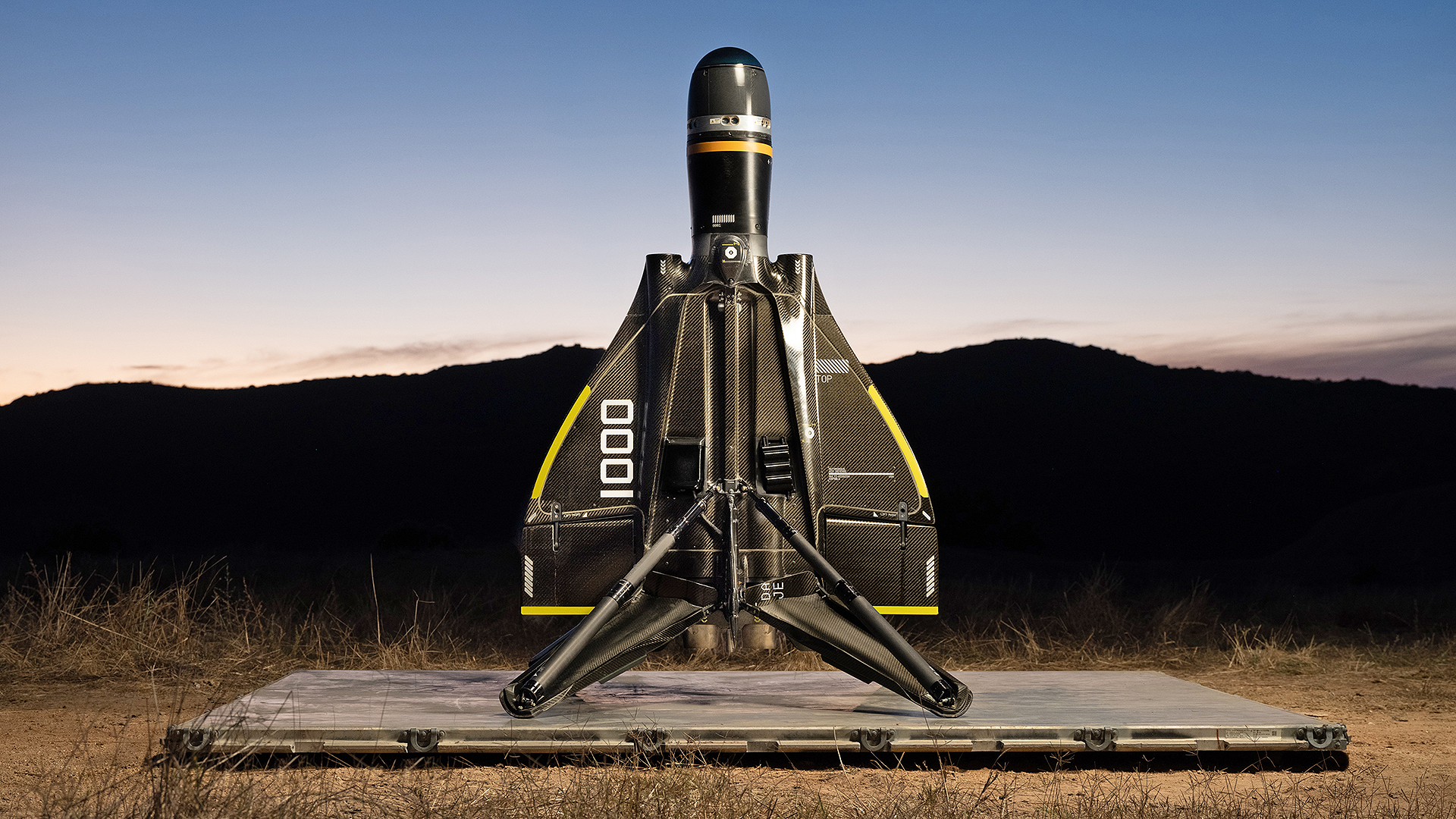A novel missile-like air vehicle called Roadrunner, with high degrees of modularity and autonomy, and that can be readily reused, has been unveiled by defense contractor Anduril. There is already a version, the Roadrunner-M, with a high-explosive warhead that can be used as a low-cost loitering anti-air interceptor with the ability to return home for refueling and reuse if it isn’t expended in the course of its mission. This is just one potential application for this twin-jet-powered platform that boasts high subsonic speed and takes off and lands vertically.
Anduril formally announced Roadrunner and Roadrunner-M today, but the company’s founder Palmer Luckey and Chief Strategy Officer Chris Brose spoke about them both at length to The War Zone and other outlets during a media call earlier this week. Though only revealed now, the Roadrunner design, which began as a sketch on a napkin, has been in development for just under two years. Full-sized prototypes have been flight-tested extensively already, including in operationally-representative demonstrations for an unspecified U.S. customer.

“It’s somewhere between a reusable missile and … a full-scale autonomous aircraft,” Luckey said in introducing the Roadrunner. “Roadrunner itself is a totally reusable aircraft and there’s a lot of payloads you can put on it where it is totally reusable.”
Luckey and Brose could only offer limited details about Roadrunner’s specific performance parameters and capabilities. They were able to say that it is capable of reaching high subsonic speeds, is shorter than Luckey is tall (his words), and is small enough to be moved around by a single average individual. It is powered by a pair of small turbojets that Anduril has developed in-house, but exactly how fast it can fly, at what altitudes, or for how long are so far undisclosed.
Roadrunner is launched vertically and, if it returns in one piece from a sortie, it lands vertically on four flip-down outriggers at the base of its body, not unlike a SpaceX Falcon 9 space launch rocket booster. Unlike a Falcon 9 booster, Roadrunner can be quickly refueled and sent back out, if desired.
“I love SpaceX, but what they’re doing requires a lot of refurbishment in between each rocket landing and relaunch … like weeks or months of work typically,” Luckey explained. “This [Roadrunner] is something that can land, get refueled, and take off inside of a couple minutes.”
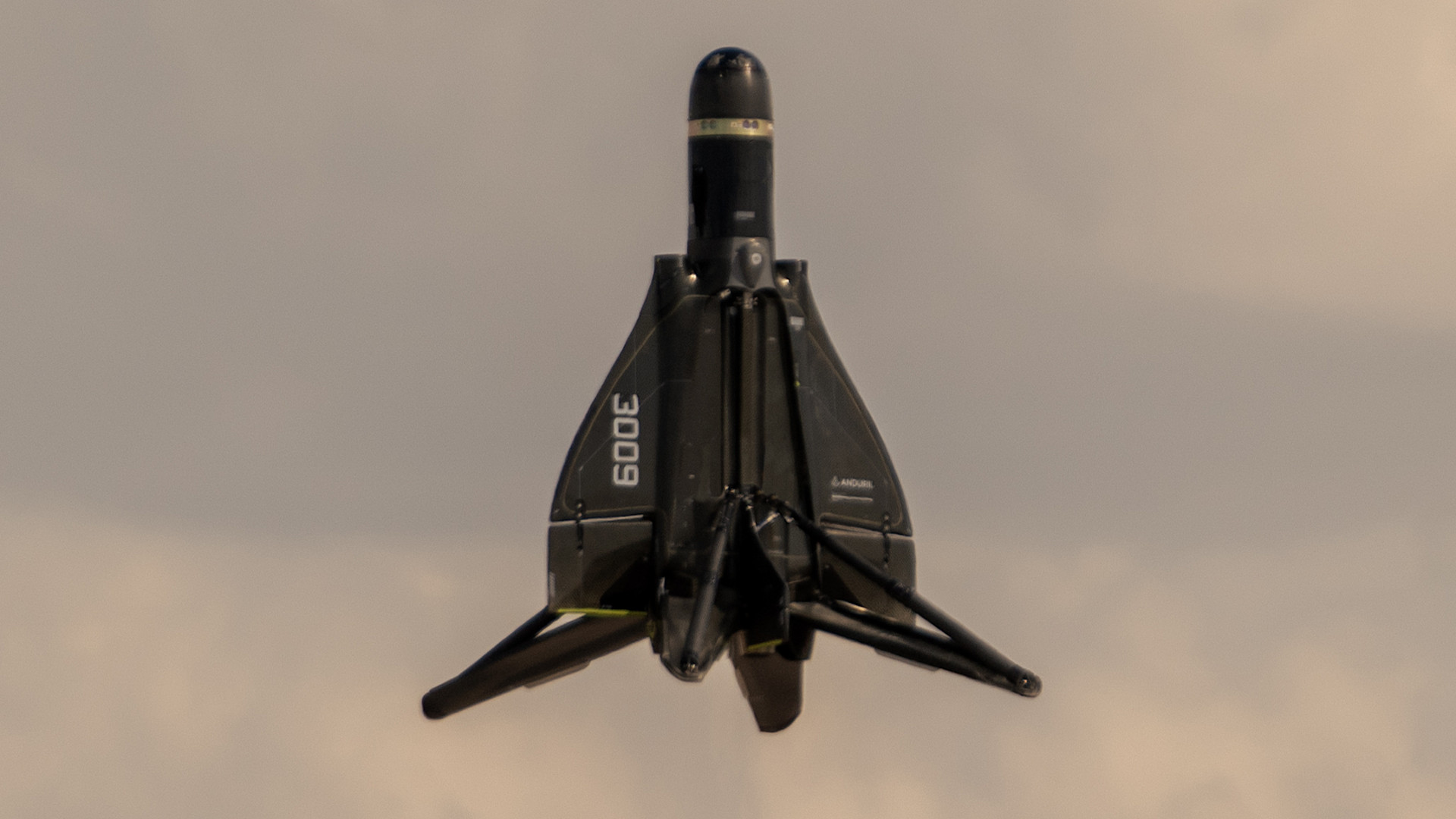
The launch system for Roadrunner now is a self-contained box-like “hangar,” also called a “nest.” Though he did not elaborate, Luckey said that this hangar has a significant amount of built-in functionality, including the ability to conduct “continuous monitoring of all the systems – health monitoring, health feedback – a variety of … maintenance functions, [and] a variety of environmental control functions.”
The nest can also be networked together with relevant offboard control systems, such as command and control networks and sensors. However, the entire Roadrunner concept is intended to allow for a single individual to launch, manage, and recover multiple vehicles by themself.
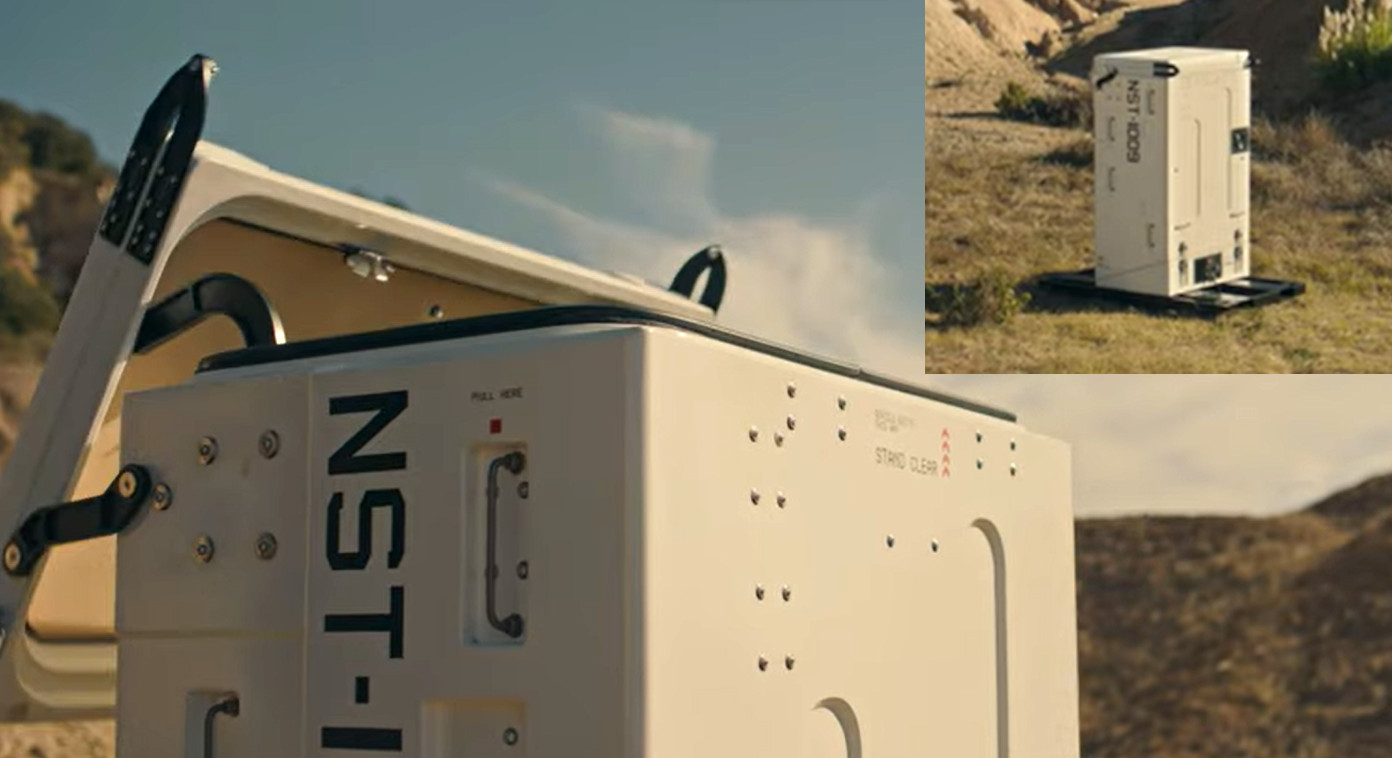
The current cost of a single Roadrunner is “in the low hundreds of thousands of dollars,” according to Luckey and that is expected to drop further as production ramps up. Anduril is set to begin low-rate production of the Roadrunner-M version, which will be hundreds of air vehicles, as part of its deal with the unspecified U.S. customer. The company hopes to quickly scale up production to thousands of units.
“Roadrunner-M innovations include faster launch and take-off timing, three times the warhead payload capacity, ten times the one way effective range, and is three times more maneuverable in G force, compared to similar offerings on the market,” according to an Anduril press release about Roadrunner, but its unclear what systems are being used as comparitives.
Other jet-powered drone-like effectors designed primarily to intercept drones do exist, but by all indications are simpler and more narrowly focused in their operational scope than Roadrunner. Raytheon’s Coyote Block 2 is a prime example that is in U.S. military service now.

As another general cost comparison, each example of the latest generation of Stinger short-range surface-to-air missile, which can be employed from shoulder-fired launchers and ones mounted on vehicles, has a price tag around $400,000. Stinger, of course, cannot be reused once it has been fired nor can it loiter looking for a target for extended amounts of time over a geographical area.
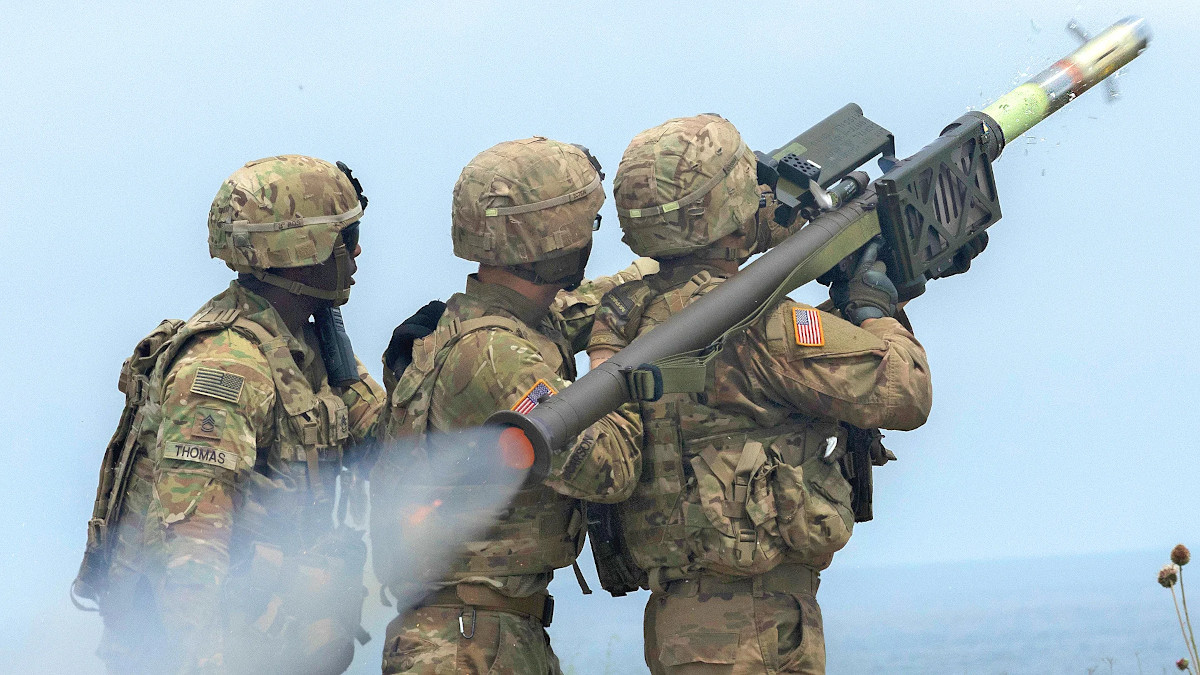
Though Anduril describes Roadrunner-M as a variant of the core system, the use of the platform as a low-cost means of intercepting a variety of aerial threats, especially drones, is what led to its genesis in the first place.
“As I think many of you are aware, … Anduril has been working on counter-UAS [uncrewed aerial systems] and air defense for about five years now,” Chief Strategy Officer Chris Brose explained. “Roadrunner was really born to that, … that early work where, through our deployments of technology, we were really seeing where the kind of advanced air threats were going.”
“To be really specific, when we first started deploying Sentry towers, the thing that really drove some of our early counter-UAS work is people, customers, saying, ‘Hey, we love to be able to detect UAS, but we need to be able to do something about them,” the company’s founder Luckey added. “Your solutions are either layered in with existing solutions that are very, very expensive and [that have] very limited magazine depth, or you build something like Roadrunner and fill the gap yourself.”

During the media call earlier this week, Brose stressed more than once that Roadrunner is not meant to be a replacement for higher-end air defense assets like the U.S. Patriot surface-to-air missile system. Patriot has been commonly used as an example in recent years of the high costs incurred by using traditional air defense assets against lower-tier threats, especially drones. The unit cost of a PAC-3 Missile Segment Enhancement (MSE) interceptor, the most modern interceptor available for Patriot, is around $5.2 million, according to the U.S. Army’s budget request for the 2024 Fiscal Year.

“We saw systems out there, you know, like Patriot missiles, that are very capable, but they’re also very expensive. You don’t want to employ them against, you know, very low-cost threat drones and low-cost cruise missiles,” Brose said. “You want to husband those resources for you know, kind of the more exquisite threats that they’re going to be required to go after.”
“We saw the threat moving beyond what, you know, kind of traditional RF [radiofrequency] defeat type solutions [e.g. electronic warfare jammers] would be workable against, because of the fact that they’re flying, more autonomous missions, etc,” he added. “And then frankly, you know, on things like directed energy, I think there’s still a lot of work to go for that to actually be an operationally useful capability, and there’s a lot that threats we’ll be able to do to counter systems like that.”
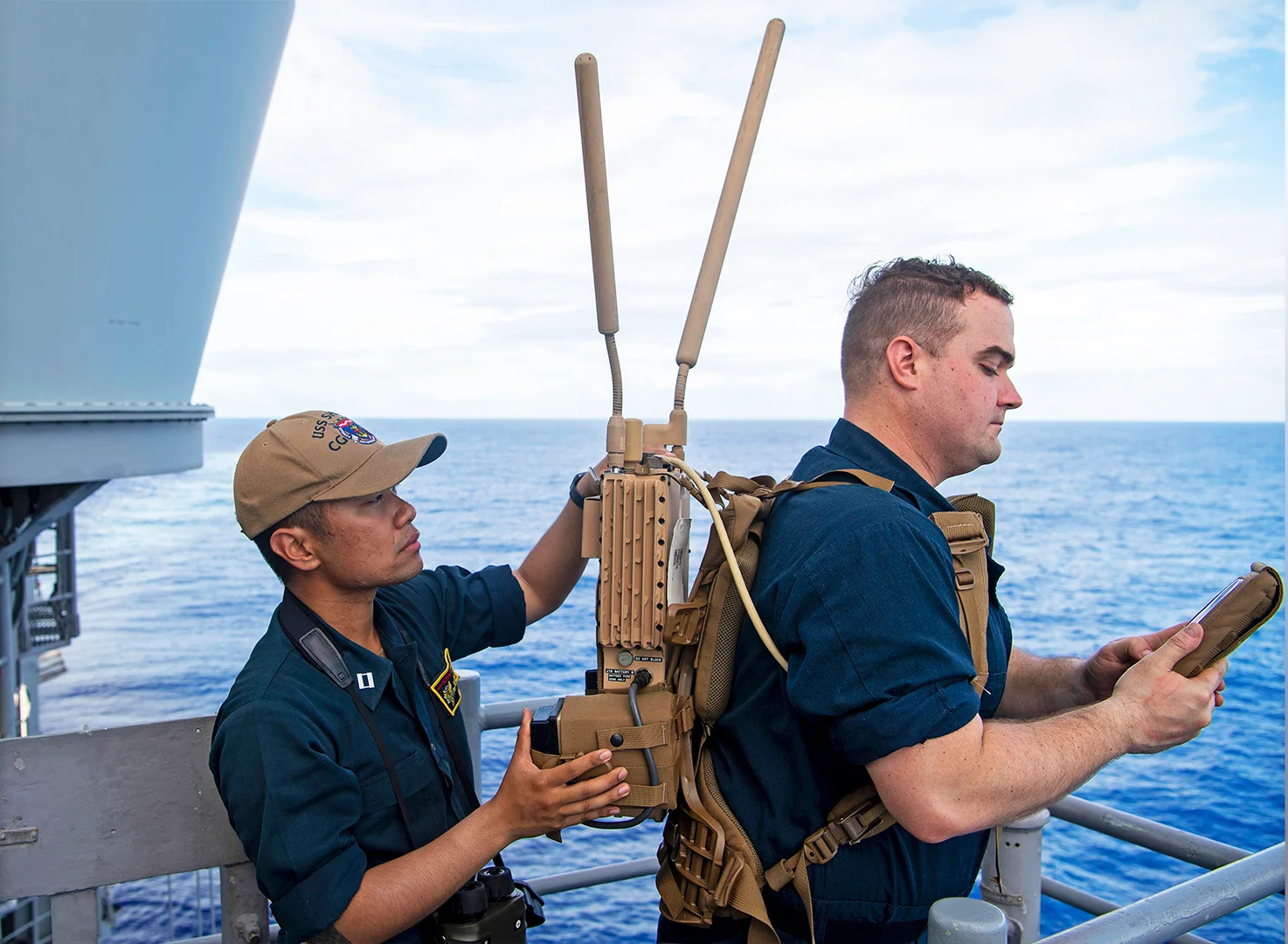
On the point about directed energy, the War Zone has written extensively on how those technologies have moved steadily from the realm of science fiction to reality. However, one drawback with lasers, specifically, is that they can only target one threat at a time. They are also impacted adversely by weather, smoke, and other obscurants found on the battlefield. High-powered microwave directed energy weapons have been presented as a way to address larger volumes of targets. Still, there are significant negatives and positives to all these systems, including range.
The threat posed by cruise missiles and various tiers of drones, which can be launched in large waves and even potentially be networked together into swarms, has only become an increasing source of concern for the U.S. military, as well as other armed forces around the world, in recent years. The conflict in Ukraine has only underscored these fears. Russia relies heavily on cruise missiles and Iranian-made kamikaze drones for strikes deep inside Ukraine. Russian forces also make heavy use of lower-end kamikaze drones, like members of the Lancet family made by ZALA Aero Group, to target higher-value assets closer to the front lines.
“You guys should look at ZALA, the Russian UAV [uncrewed aircraft] manufacturer. In Ukraine, all the guys are just calling everything that’s coming in for them ZALAs,” Luckey said. “That’s the category of stuff that people are freaked out by.”
Roadrunner-M proposes to address the issue of the cost to defend against high volumes of cruise missiles, drones, and other aerial threats by using relatively cheap effectors that can be relaunched if they do not actually prosecute a target in the course of a mission. Anduril is also pitching the concept as offering a high degree of operational flexibility, since these air vehicles could be sent into a designated area at the first sign of danger and then recovered for reuse if it turns out to be a false alarm. They could even be deployed proactively to keep watch for potential threats in a designated area, and be redirected elsewhere as the situation demands.
“The benefit of the Roadrunner, right, is that you can launch without regret,” Brose said. “At the moment a sensor detects what you even think might be a threat, an operator can make a decision to deploy a Roadrunner to go out into that sort of general threat environment, conduct additional intelligence, surveillance, reconnaissance, targeting, and, in the event that you actually want to employ it for a defeat solution, you can do that too.”
“If it turns out that you don’t, or if it turns out that that threat is not a threat, you can recall it, recover it, and reuse it,” he continued, adding that this is a capability that has already been demonstrated in testing.
“Similar to traditional approaches to deter and defeat incoming aerial threats like scrambling expensive and airfield-dependent jets, Roadrunner-M can take off, follow, and intercept distant targets at the first hint of danger, giving operators more information and time to assess the target and rules of engagement,” the press release that Anduril put out. “This radical shift in thinking allows for large-scale defensive launches at extraordinarily low cost, increasing redundancy for higher probability of lethality and enhancing the ability to simultaneously engage many targets.”

Exactly how Roadrunner-M is cued to its target or otherwise seeks it out, and what specific capabilities it has to gather information about it or conduct intelligence, surveillance, and reconnaissance missions more broadly, are unknown. It is understood to have a high degree of autonomy and the entire system is designed to be capable of being tied into various existing and future air defense network architectures.
“Roadrunner has onboard processing onboard sensors that allow it to find targets, calculate an optimal intercept path, and then take that target out,” Anduril’s founder Luckey said. However, it is “not tied to its own bespoke fire control system or radar system. You can integrate it with any other system that you want to integrate [with] to get a cue off of.”
“We’ve integrated Lattice, our AI engine, with a lot of different air defense systems, with a lot of different radar systems,” he continued, using that artificial intelligence-based mission command system as an example of other relevant work the company has done in the past. “We also make our own” sensor and fire control options to meet these needs.

“This is kind of one of the core value propositions of Anduril is that we deliver this integrated air defense solution, not just for Roadrunner, but for other UAS, from small UAS all the way up to full-size aircraft,” Luckey added. “So, I’m happy to sell anybody a full, all-up air defense system, but if they want to tie this into some other queueing system, then I’m happy to do that, as well.”
The nests are also designed to withstand various harsh environmental conditions and remain functional for months at a time without any need for in-person maintenance or inspections. This would allow them to be deployed in a highly distributed manner and activated remotely, as well.
The hangars are small enough that they could be loaded onto ground vehicles, watercraft, or other mobile platforms, further increasing the overall system’s flexibility. Roadrunner-M might be particularly useful in shipboard applications, helping to maximize magazine depth during operations that could be very far from established supply lines.
Interestingly, the idea of a loitering anti-air interceptor has emerged before with a curious Iranian design known only as the 358, which you can read more about here. Versions of this weapon have been employed by Iranian-backed Houthi militants in Yemen, who claim to have used them to shoot down drones belonging to Saudi Arabia and the United Arab Emirates. The missile-like 358 is, by all indications, a far less advanced system than Roadrunner-M and it cannot be recovered for reuse, but it has already highlighted the potential utility of many of the same general operational concepts.
In addition, though Anduril’s main focus with Roadrunner is on the M version as an air and missile defense assets, the company makes clear that the platform is modular and is intended to be readily adaptable to other roles and missions. This might include using versions with high-explosive warheads to conduct air-to-surface strikes in a kamikaze mode. The system could be used for entirely non-combat tasks, too.
Though Anduril’s Luckey and Brose did not want to speculate too deeply on what other mission sets Roadrunner could be used for, they did disclose that a version of the platform is currently competing in the XPRIZE Wildfire challenge as a potential tool for rapidly detecting, assessing, and helping to put out wildfires. This competition is being run by the XPRIZE Foundation, a California-based non-profit that works “to inspire and empower humanity to achieve breakthroughs that accelerate an abundant and equitable future for all,” according to its website.

Though we don’t know yet how the firefighting version of Roadrunner works – Luckey said he’s “trying to keep some secrets to myself because I am still competing in this prize” – the kind of functionality required to find fires and then using some kind of payload to help snuff them out could easily translate to the military realm. At its core, this is just finding a target, very likely via its thermal signature, and then employing some kind of effect to neutralize it.
Beyond its specific capabilities, Roadrunner also epitomizes Anduril’s broader visions about the kinds of systems that the U.S. military, in particular, will need to succeed in the future and the kind of development and production processes required to generate them in useful quantities.
“One of our main motivations as a company has always been ‘prove it’ … We’re not big enough … [to be] going out and hyping ourselves up on LinkedIn and showing glossy renders of things that don’t exist,” Brose, the company’s Chief Strategy Officer, said. “Our focus is more on actually putting our money where our mouth, is leaning in where we have conviction, building solutions that we believe are possible and [that] meet current and future requirements are a novel way.”
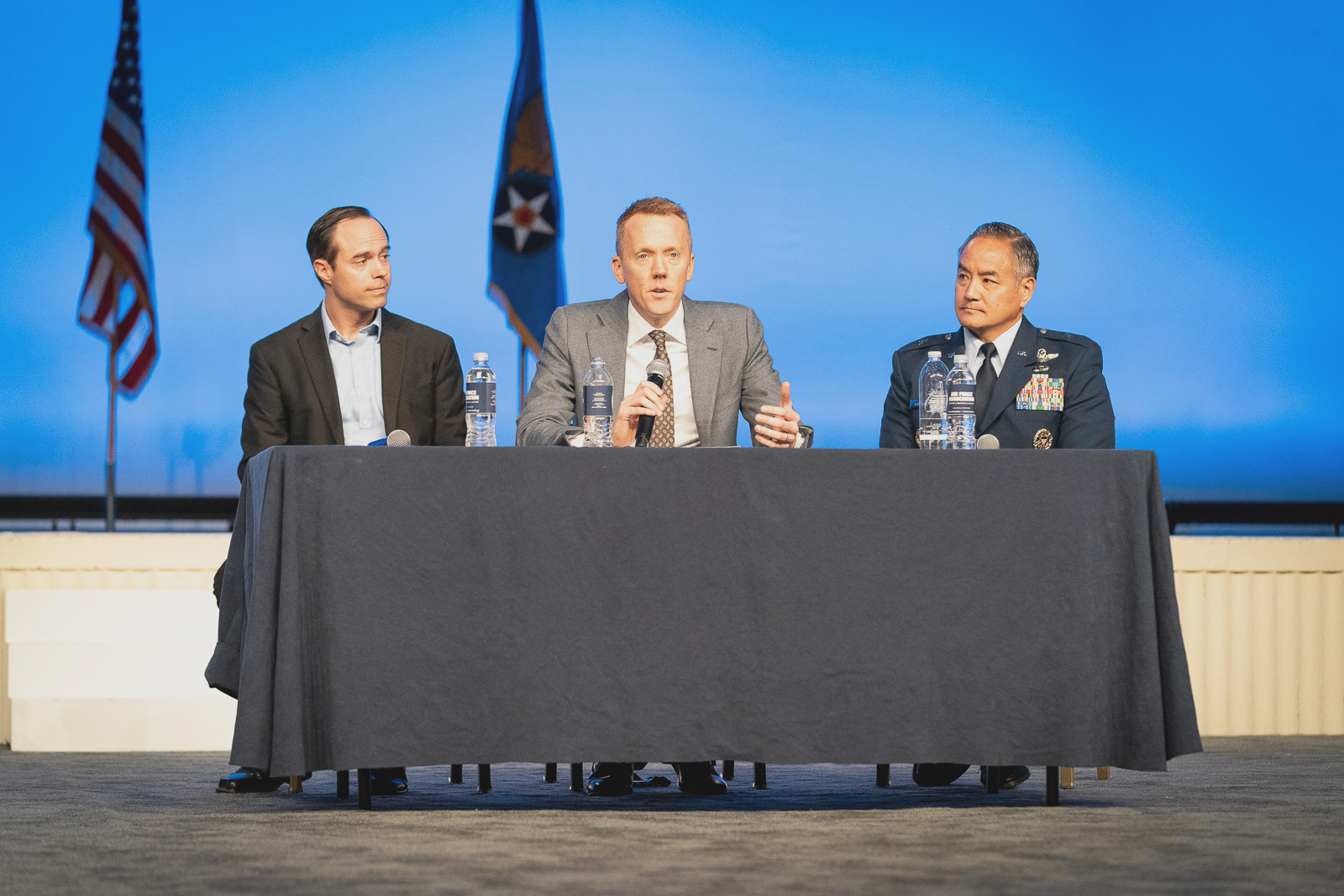
“We think of ourselves as a defense products company more than a defense contractor,” Anduril’s Founder Luckey added. “We use our own money and decide what to build, how to build it, when it’s done, and then we try to bring working technology to a customer.”
Roadrunner’s design, which has a heavy focus on being producible at scale and to take advantage of economies of scale in a significant way, typifies this view.
“There were some things that you could not make cheaper by making thousands of them or making a million of them. Roadrunner, all the things that are expensive on it are the things that get cheaper when you make a lot of them,” according to Luckey. “There are no fundamentals on there that make it all that expensive.”
This was what drove Anduril to develop proprietary engines for Roadrunner.
“So, we’ve been investing in building our own turbojet engines. They’re the most power-dense turbojet engines that have ever been built, as far as I’m aware. There are some of the fastest starting jet engines of any size that have ever been ever been built,” Luckey said. “And because we’re building those, we can control the performance, but even more importantly, we control the cost.”
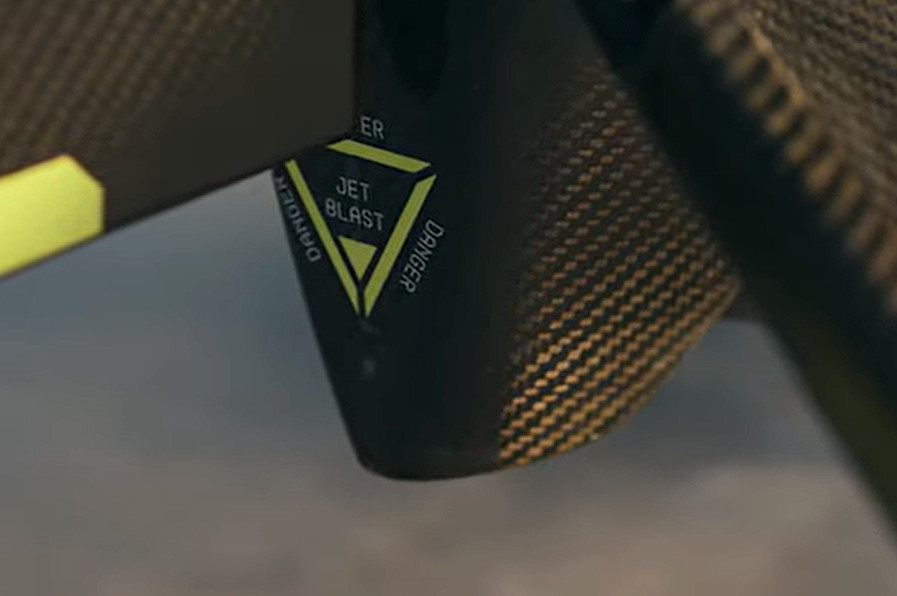
“What we’re putting together from a modern manufacturing standpoint, really gets at the mass producibility requirement that has to go toward a weapon like this. … I think there’s a lot of talk in [the] defense [sector] about … how artificial intelligence and autonomy, and sort of technologies like that, have really surpassed were of kind of the traditional industrial base is,” Anduril’s Brose noted. “I would say the same is true for a lot of modern manufacturing practices. You know, when you look at how Tesla for example, manufactures cars, it’s very different than how traditional defense industry manufactures a lot of traditional defense capabilities.”
Brose made a comparison to Tesla’s production practices in a previous interview with The War Zone where he also acknowledged that there were significant differences between electric vehicles for average consumers and advanced weapon systems. That interview was focused on Fury, a high-performance drone design Anduril announced the acquisition of, along with the company that developed it, earlier this year. We had been following the story of that uncrewed aircraft closely and published a very detailed feature on the story behind it and its prospects for the future in September.

At the media roundtable earlier this week about Roadrunner, Luckey also noted that Anduril’s head of manufacturing is an ex-Tesla employee and that this factored heavily into the decision to hire them.
That individual is “personally overseeing the stand-up and expansion of the Roadrunner production line, really looking at every place we can optimize for reduction of cost, reduction of complexity, increase of production capacity, etc,” according to Brose. “That’s really a core focus of ours moving forward, not just with Roadrunner, but across a lot of different products.”
Roadrunner’s public debut has also come amid a clear attempt at a culture shift within the U.S. military when it comes to how it procures and fields uncrewed systems and other supporting technologies, including AI-driven systems. Earlier this year, the Pentagon announced the start of the Replicator initiative which, as it has been described so far, is primarily intended to help provide added impetus for the development and acquisition of thousands of lower-tier uncrewed platforms.
Roadrunner, “along with a bunch of other things that we’re building are directly applicable to the thinking of Replicator, which is, how do we build at scale autonomous systems and field them extremely quickly in scale that matters,” Luckey said. “Road Runner and a few other things that are Anduril is building, some of which are public, some of which are not, are all oriented at what Replicator’s trying to do.”
Altogether, there is clearly still much left to learn about Roadrunner and Roadrunner-M and their capabilities. Hopefully, more details about this very intriguing platform, as well as its U.S. customer, will now begin to emerge.
UPDATE 12:00 PM EST:
A story that Bloomberg published today, based in part on a demonstration of Roadrunner-M the outlet observed in November, offers additional details about how the system finds and engages threats.
In the November demonstration, which took place at a site called Jackass Flats near Nevada National Security Site, one of Anduril’s Sentry towers was used to spot and track the target drone, according to Bloomberg. The sensors on the tower provided “information about its speed and trajectory” which was then fed “into the company’s Lattice software.”
“The test pilot received imagery of the drone and then manually marked it as a hostile threat” and then launched the Roadrunner-M, Bloomberg‘s piece adds. “It took off toward the target and then began feeding its own sensor data and imagery into Lattice.”
The test pilot then commanded the Roadrunner-M to engage the target and the Lattice-enabled mission command suite displayed information showing the intercept had been successful. In this instance, a proximity sensor on the air vehicle was used to determine that it had succeeded in its task in lieu of a live shootdown. This was done to allow the platform to return to base to demonstrate its vertical landing capabilities, according to Bloomberg.
Bloomberg also noted that the air vehicle’s construction makes heavy use of carbon fiber.
UPDATE 12:50 PM EST:
User @AirPowerNEW1 on X, formerly Twitter, has noticed that official U.S. military presentations earlier this year actually mentioned Roadrunner (“Road Runner”) and identified it as a U.S. Special Operations Command (SOCOM) counter-drone program, but did not provide any other real details. One briefing slide, seen in the post below, also shows that Anduril’s Sentry towers, which have been demonstrated as a way to cue Roadrunner-M, are already in use by the U.S. special operations community.
Contact the author: joe@thedrive.com
